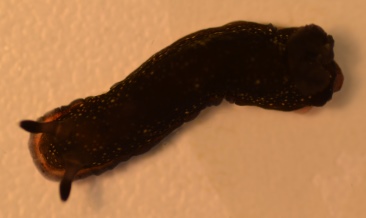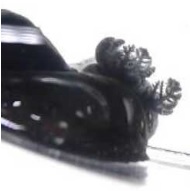|

|
| Figure 1: Dendrodoris nigra. Original Photo by Elsie-Mary Felix |
Dendrodoris nigra is an
unmistakable velvet smooth, black bodied, dendrodorid nudibranch (Figure 1) (Willan and
Cobb, 2006, Willan and
Coleman, 1984). Dorid nudibranchs display
visible gill structures often forming circles or rosettes on their posterior
back around the anus (Figure 2). As a cryptobranch dorid, D.nigra has the ability to retract its finely branched 6-8 gill
plume into a pit on the top of its body, so may or may not be present when
inspecting the animal (Behrens et
al., 2005, Brodie et
al., 1997).
 |
| Figure 2: D.nigra's gill plume. Original photo by Elsie-Mary Felix |
D.nigra’s body form is usually broad
and elongate with rather thin undulating margins and is soft and slimy to touch
(Willan and
Coleman, 1984, Brodie et
al., 1997, Willan and
Cobb, 2006). The animal is often completely black but comes
in a several colour forms. These include an entirely black body with white
specking or a dull red submarginal band (Figure 3) (Willan and
Cobb, 2006).
|

|
| Figure 3: Two colour variations of D.nigra from Suva, Fiji. A:38mm. B: 45mm. Taken from: Brodie et al, 1997. |
D.nigra
is relatively large in size, in comparison to other nudibranchs usually
measuring 30-50mm in adults but can reach a maximum size of 85mm (Willan and
Coleman, 1984). It lays an orange
spawn mass which gives rise to orange-red juveniles which turn black as they
mature , usually around 15mm in length.
Dendrodoris nigra can
also be identified by its club-like rhinophores which are black with a very
small spot of white at the tip and can also be retracted into rhinophoral
pockets (Figure 4) (Willan and
Cobb, 2006, Brodie et
al., 1997). D.nigra has an extremely small head and as a
member of Dendrodoridae lacks a radula. Instead, it has a pore-like mouth with
a long suctorial tube. D.nigra’s thin oral tentacles are inconspicuous due to
their fusion with the under surface of the animal.